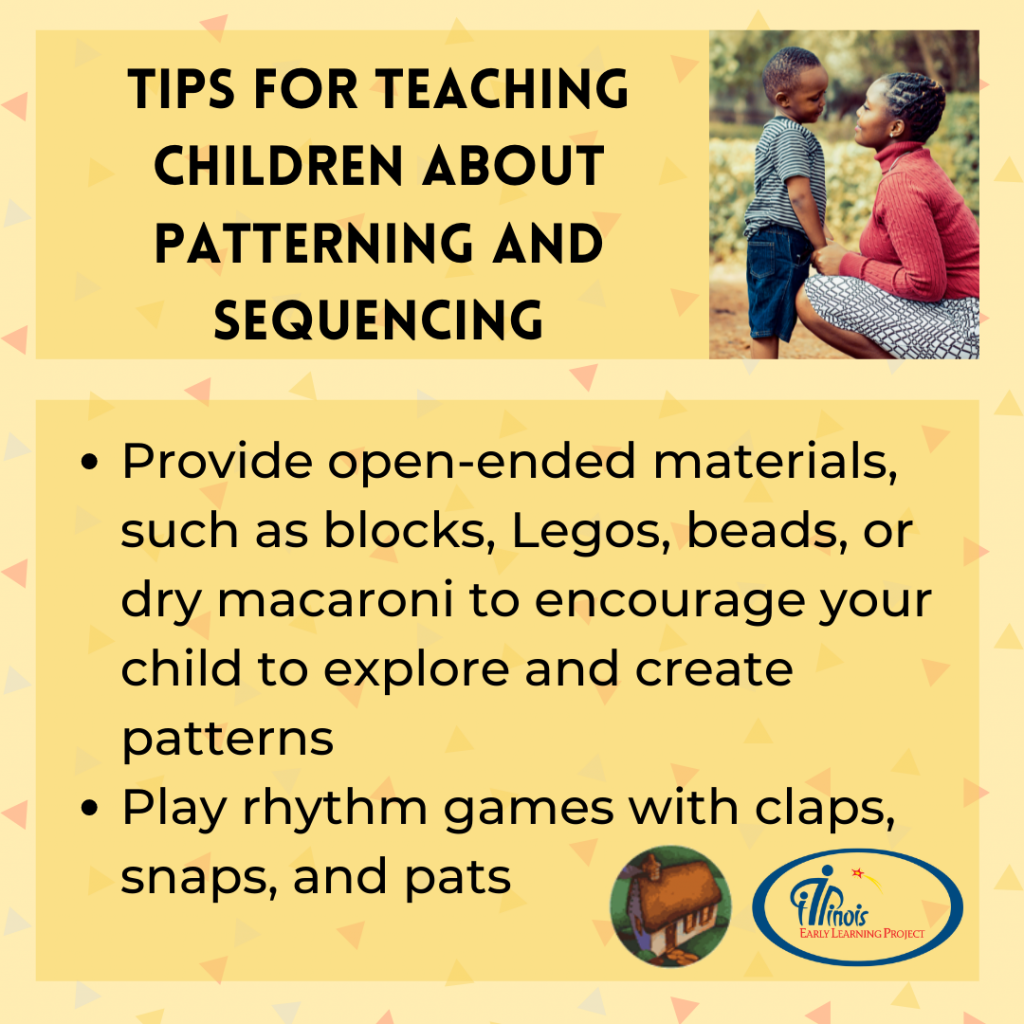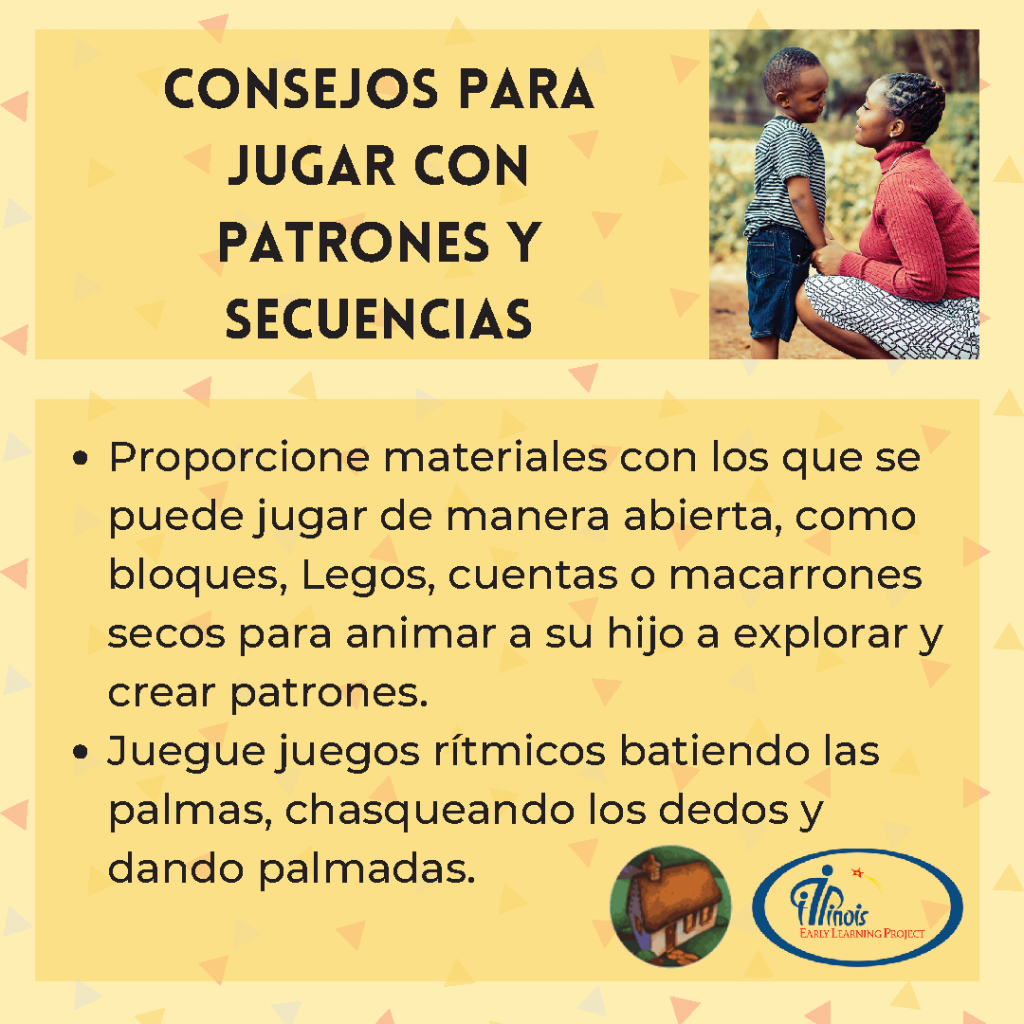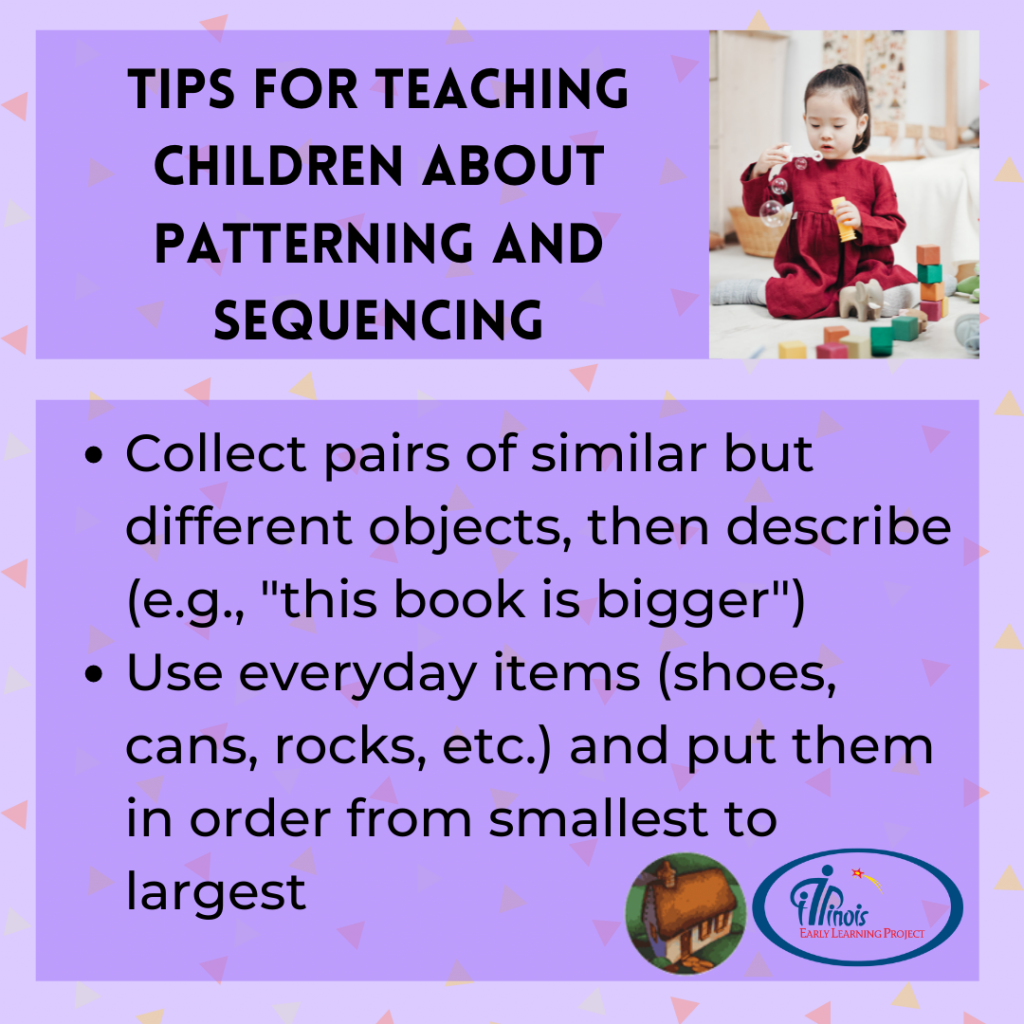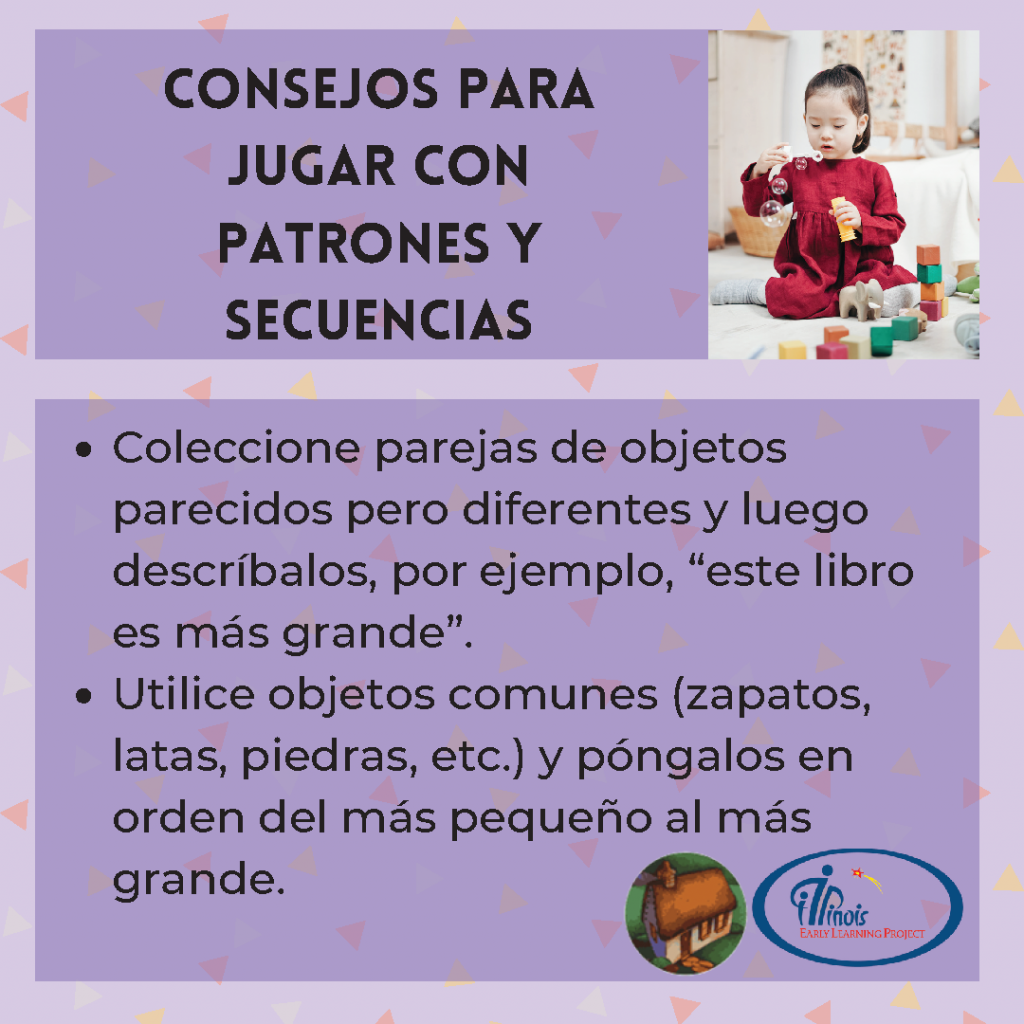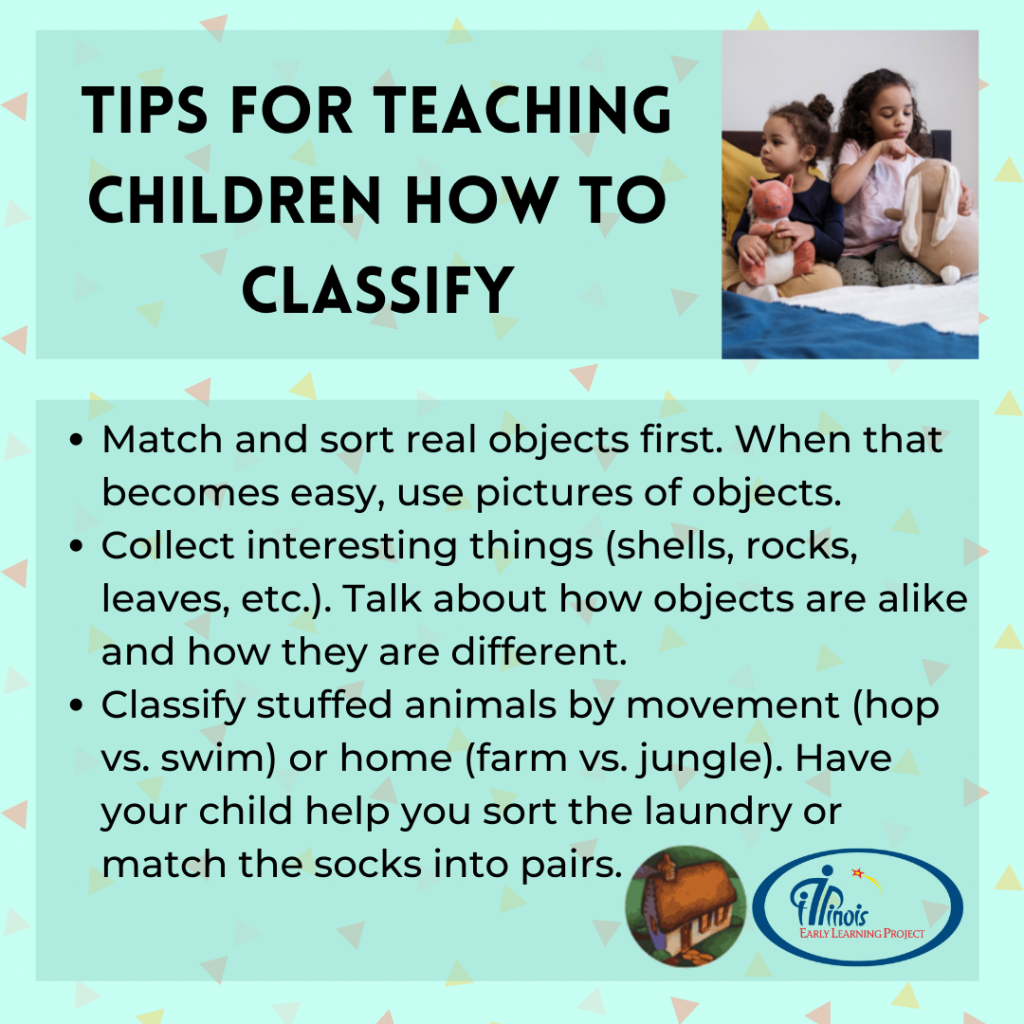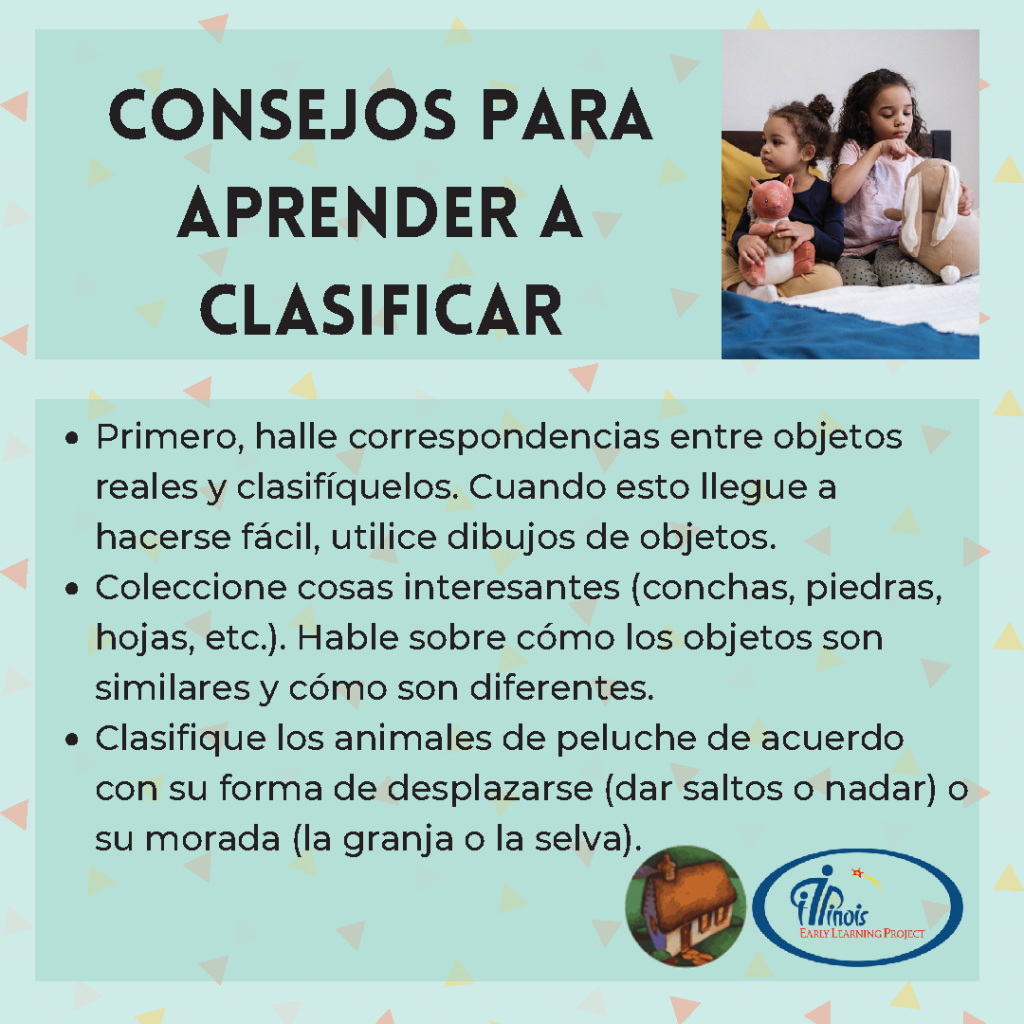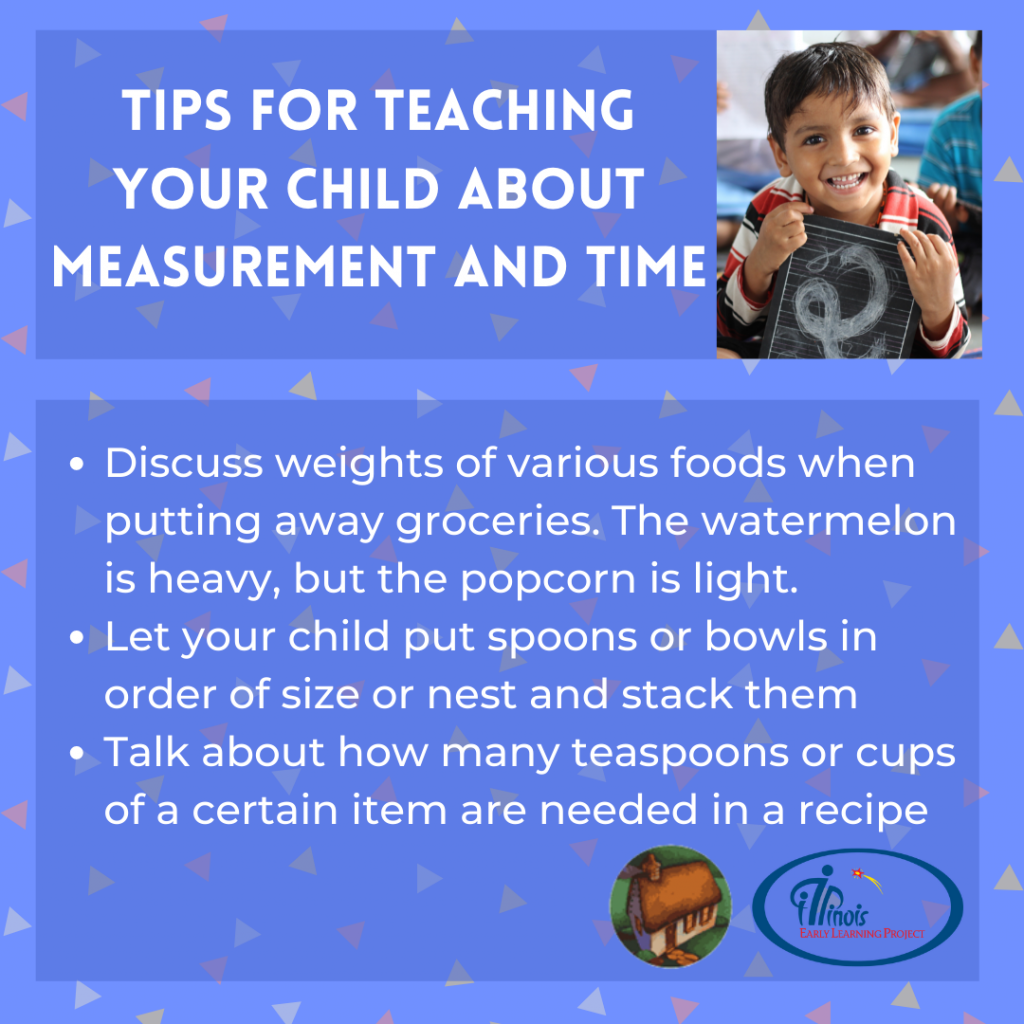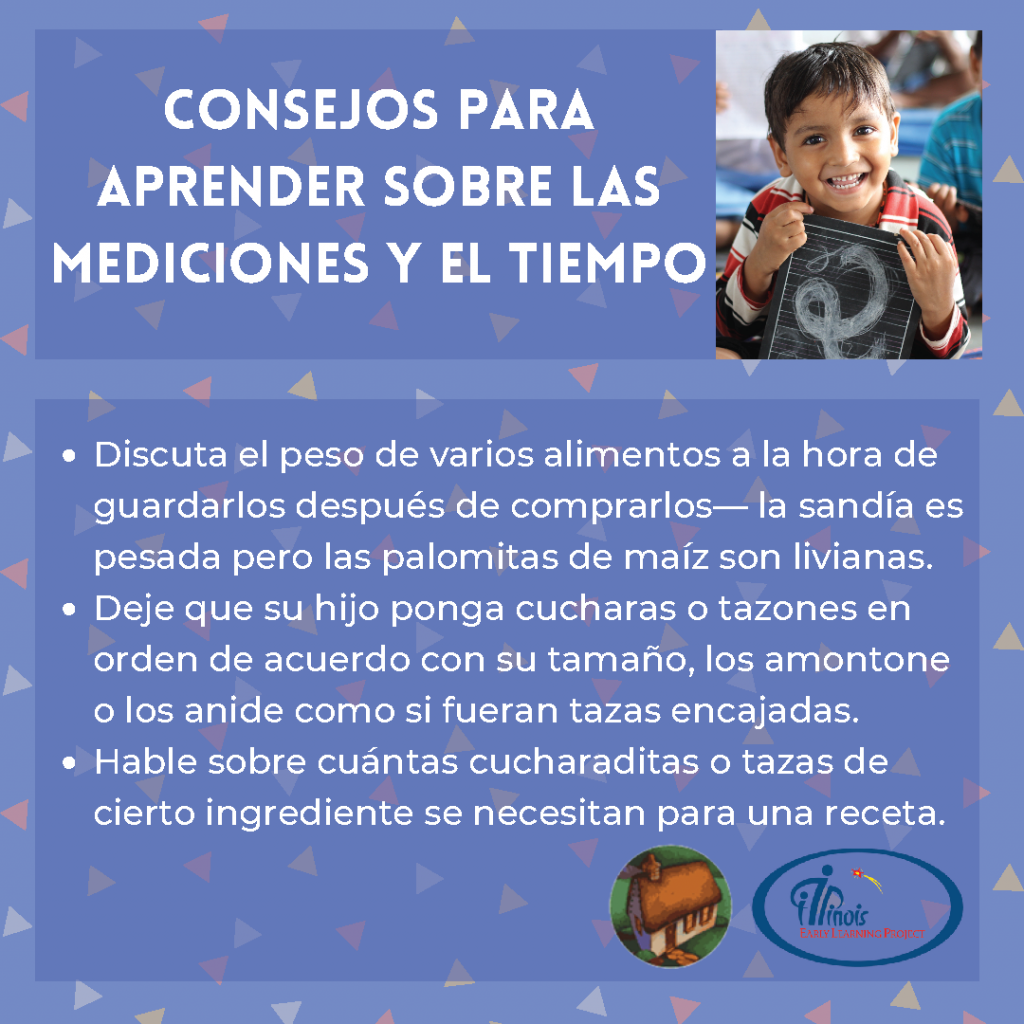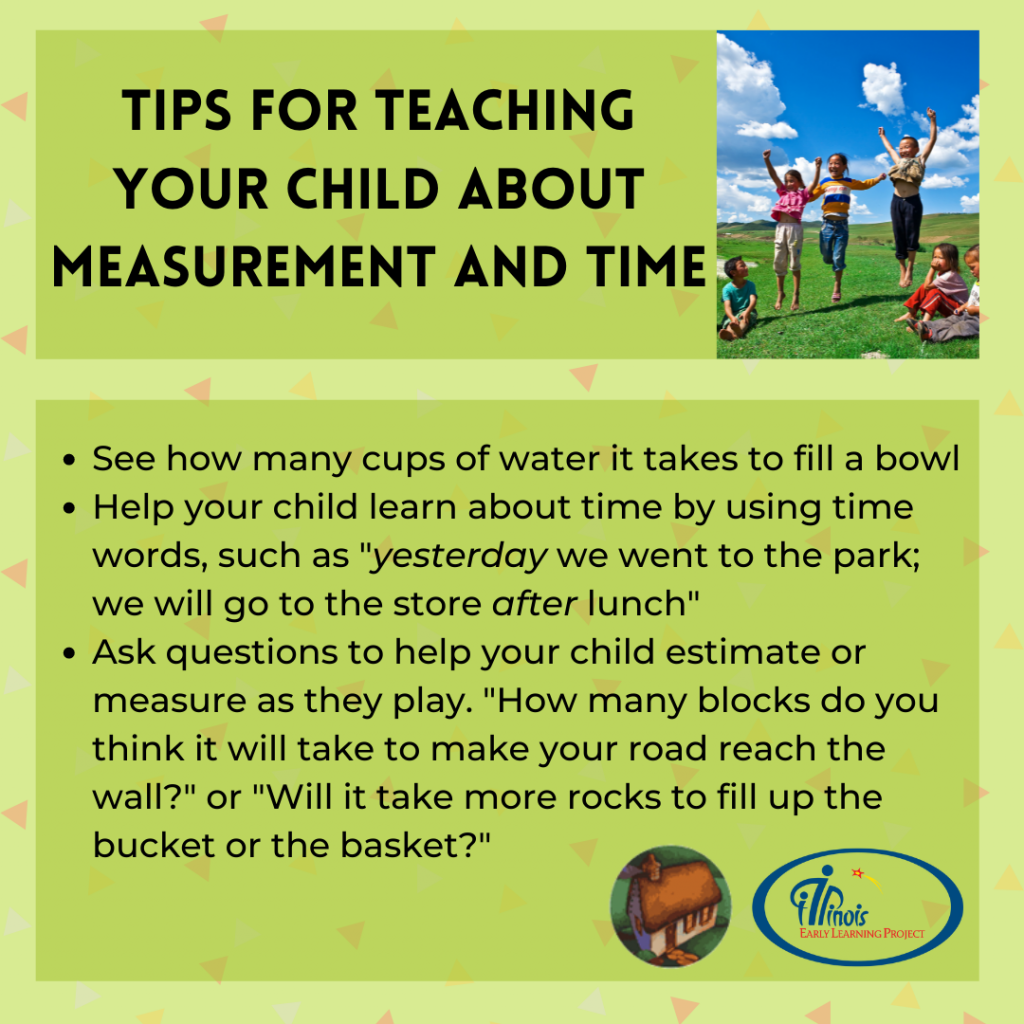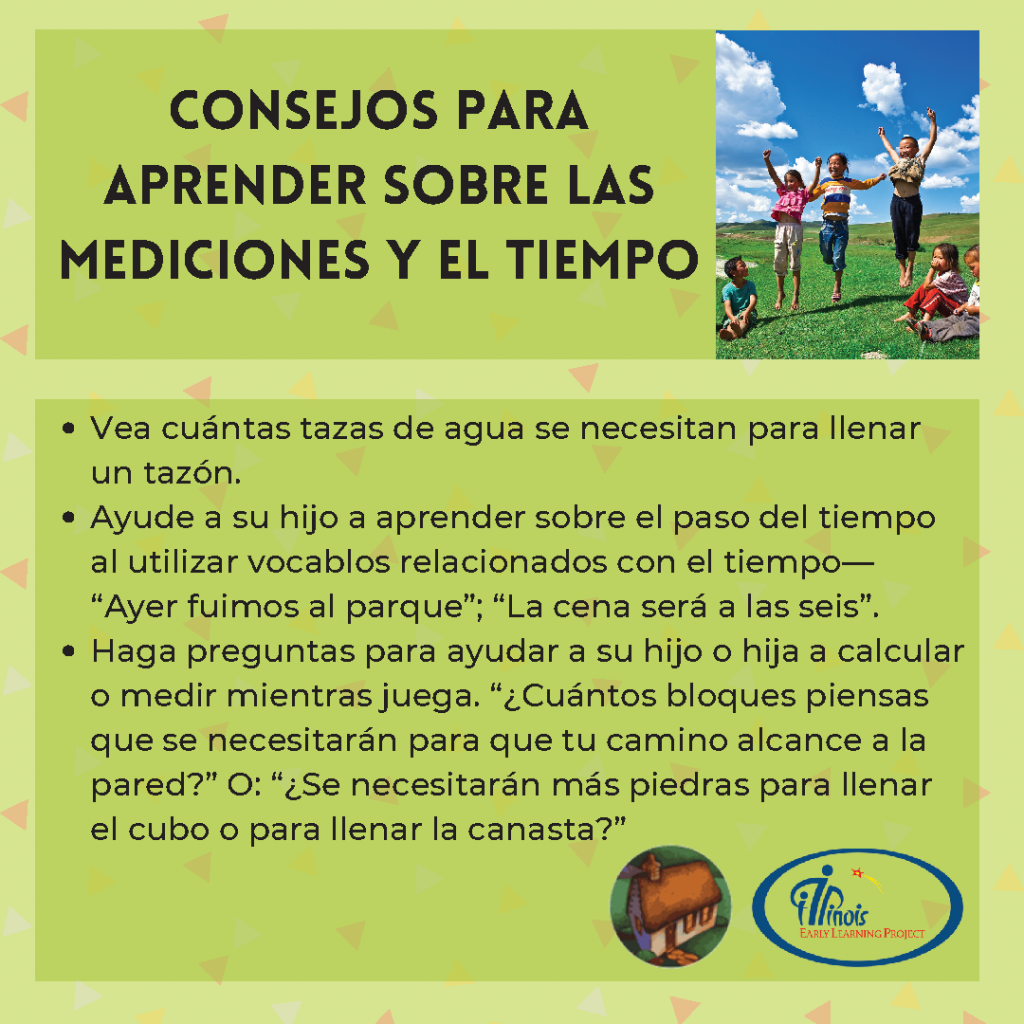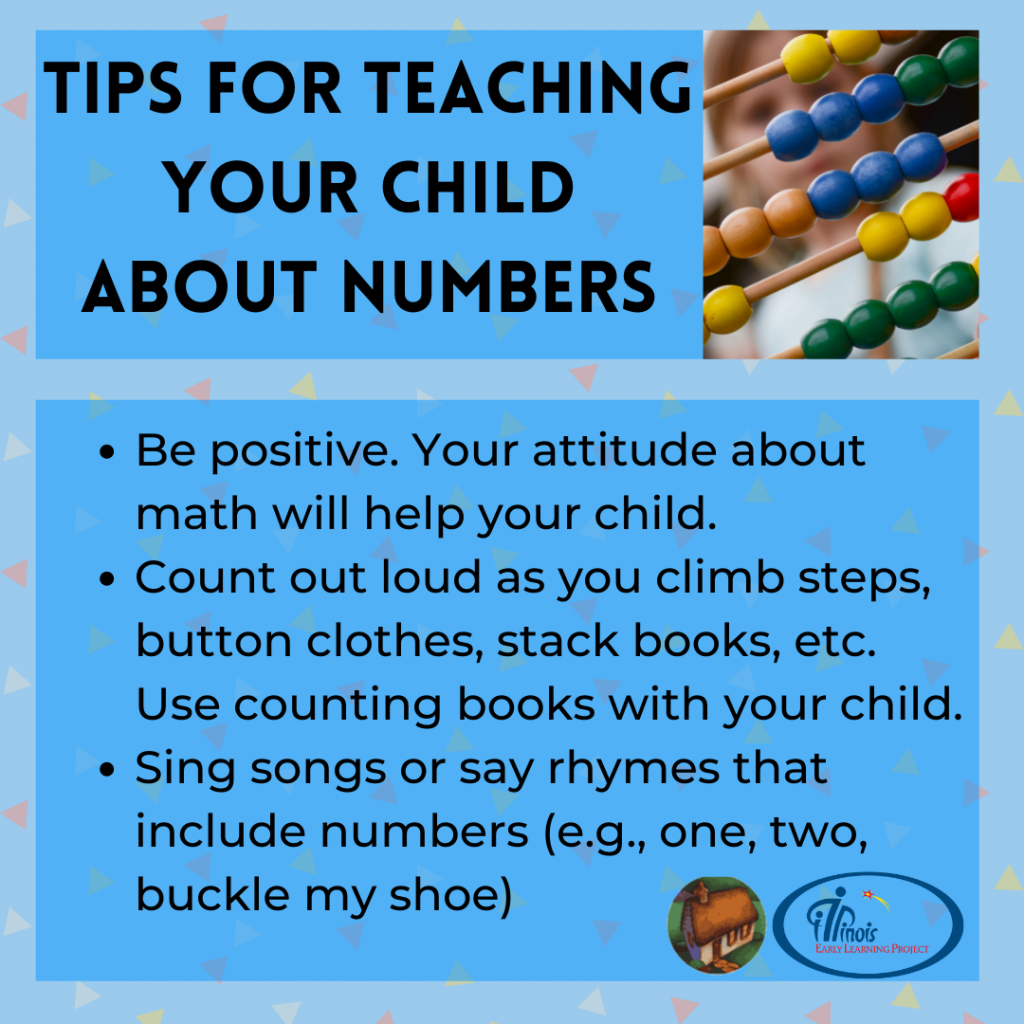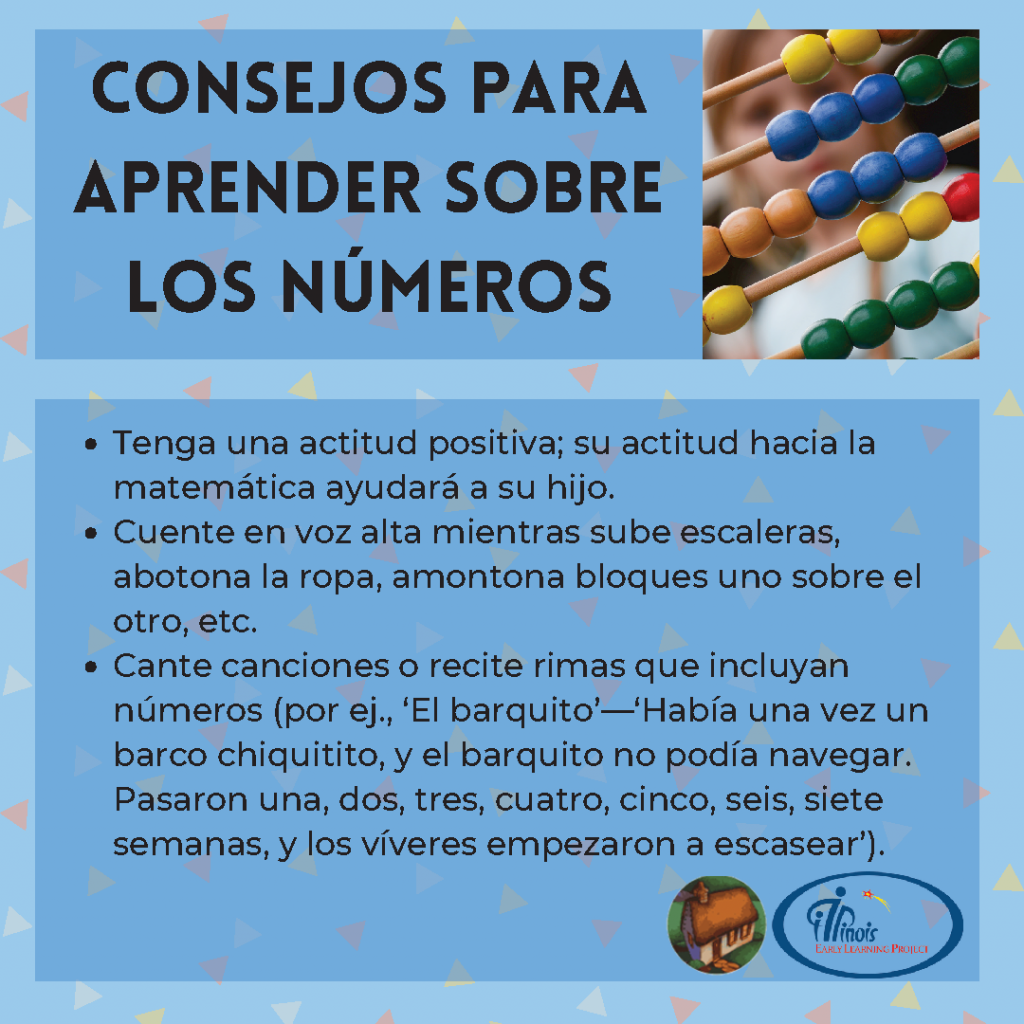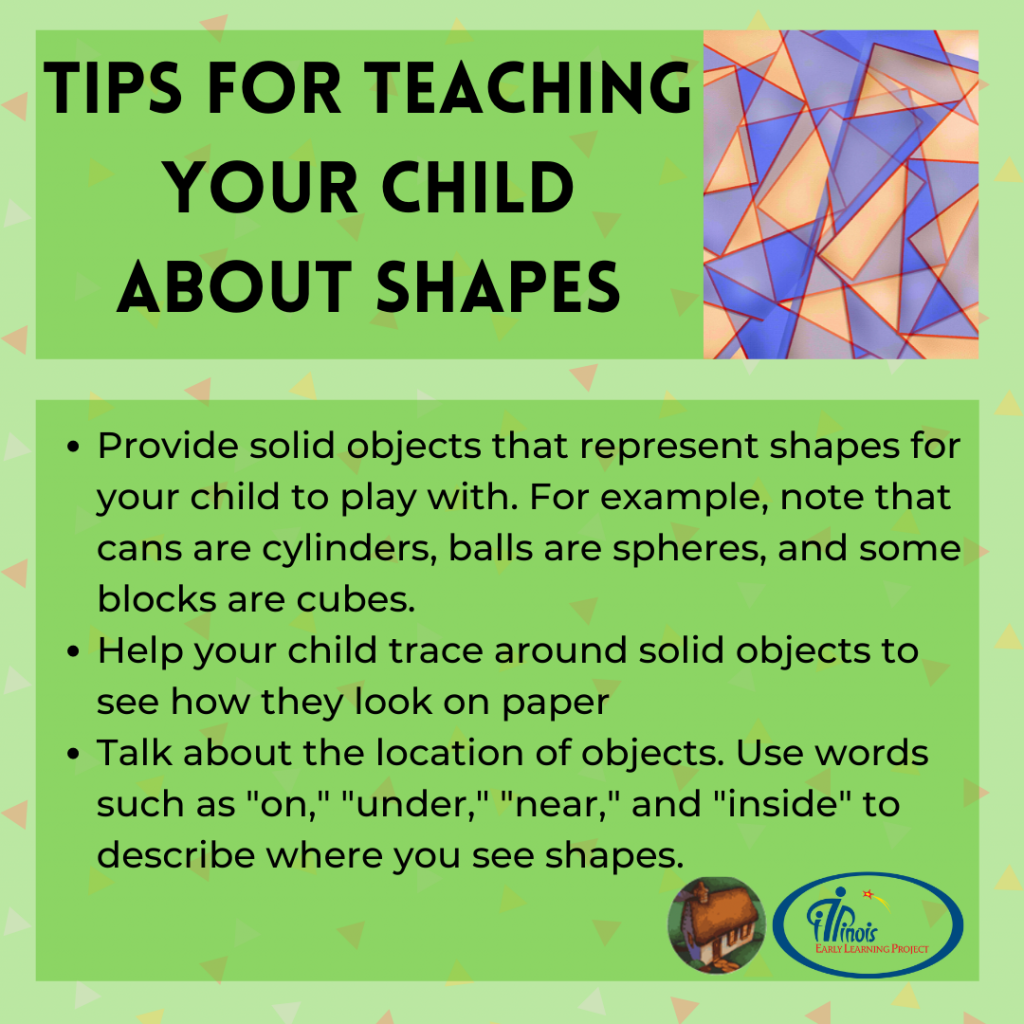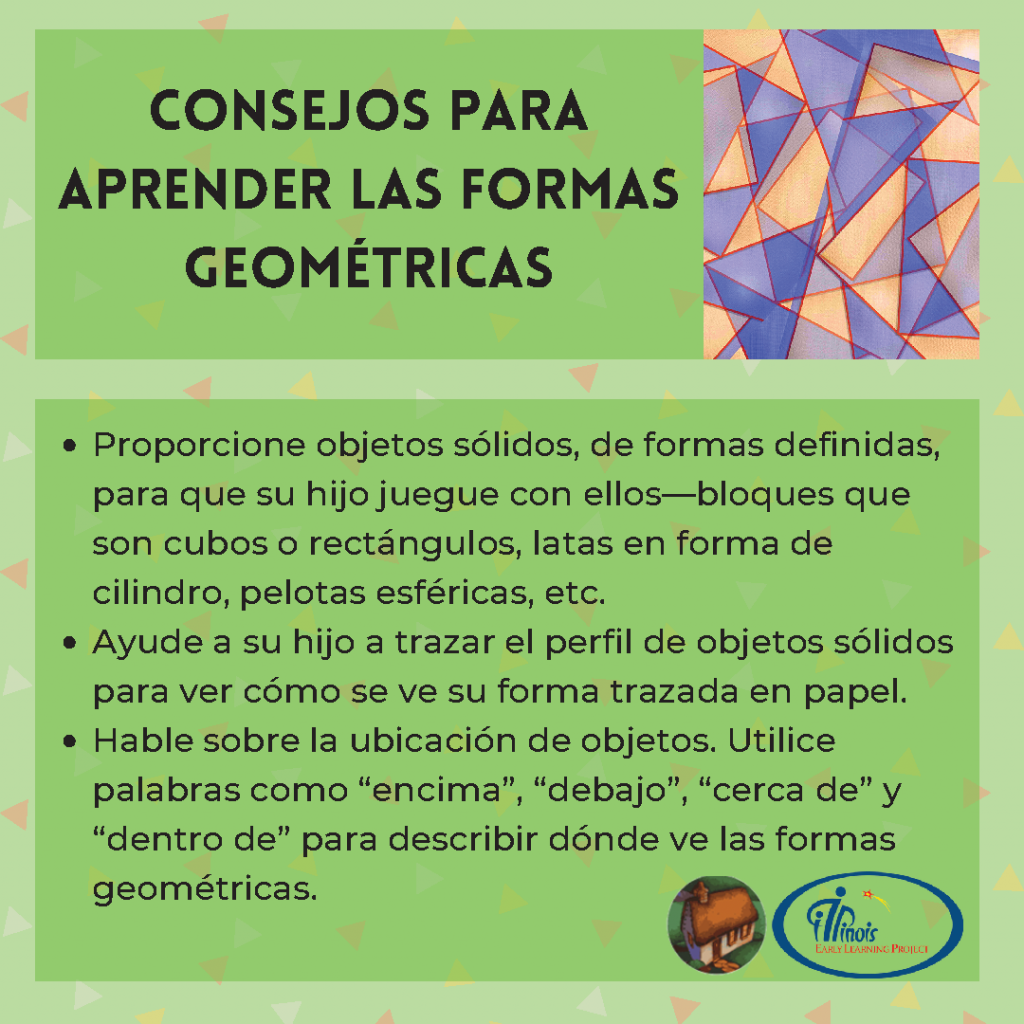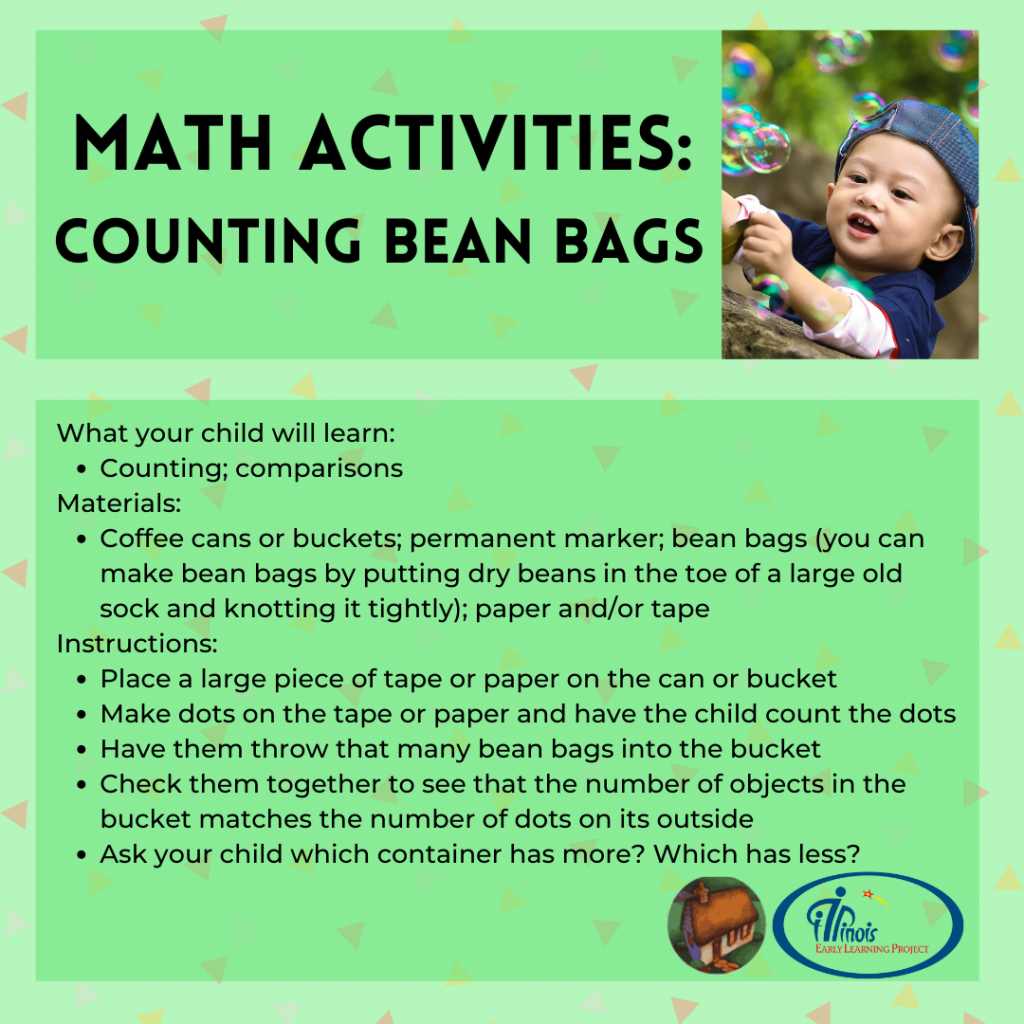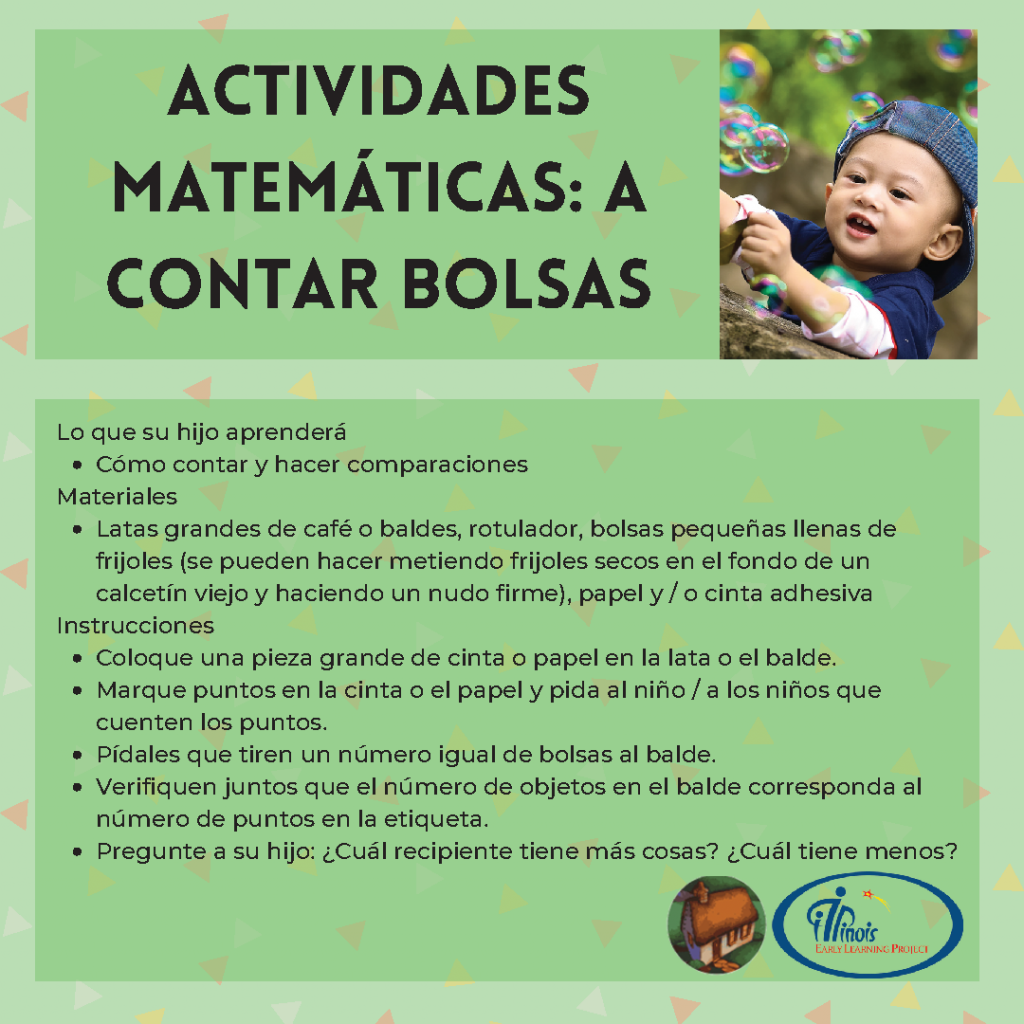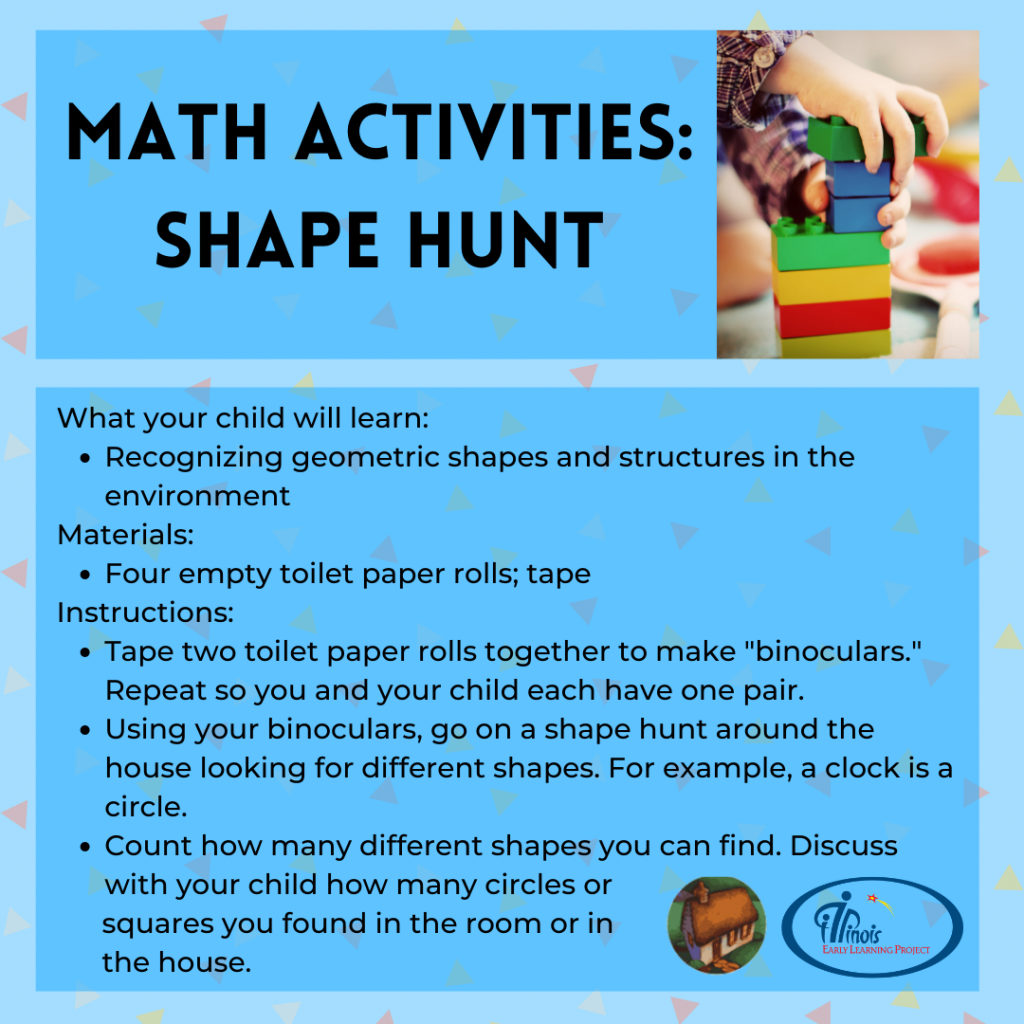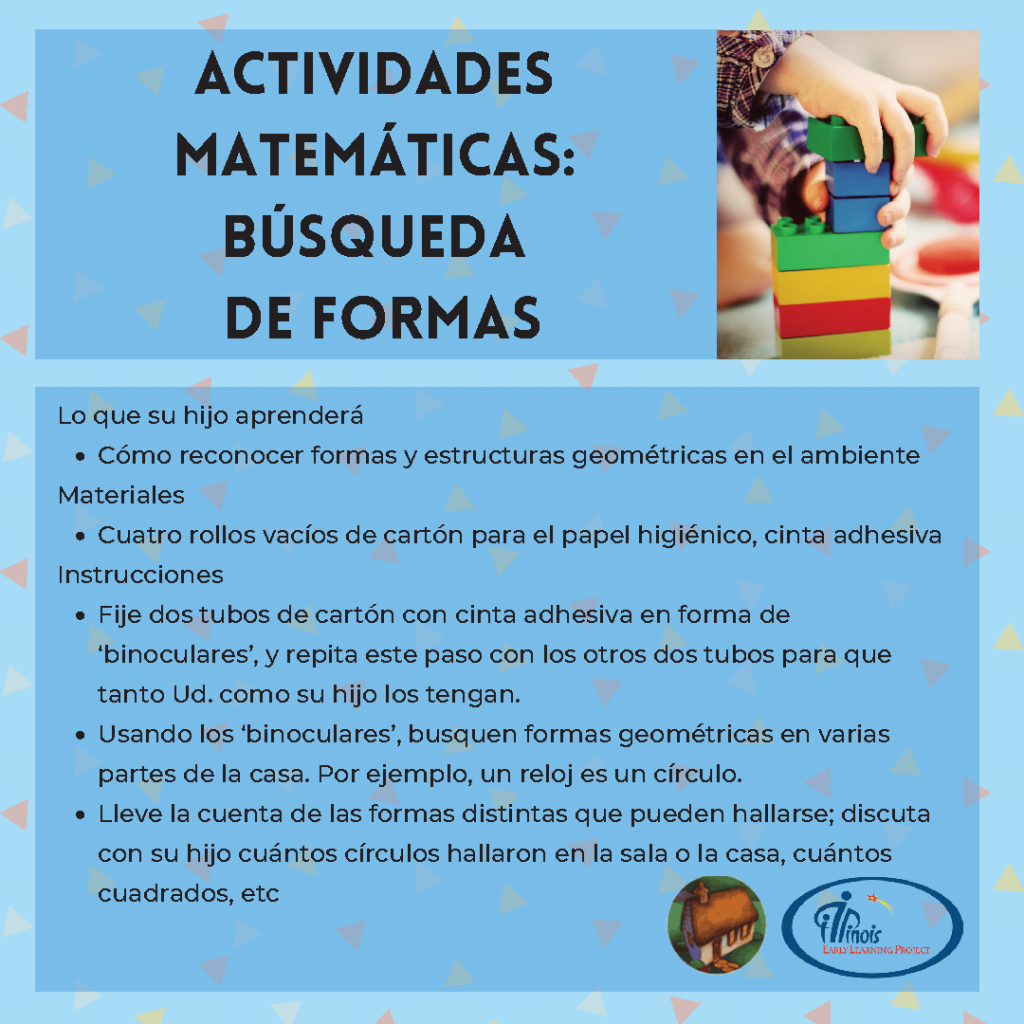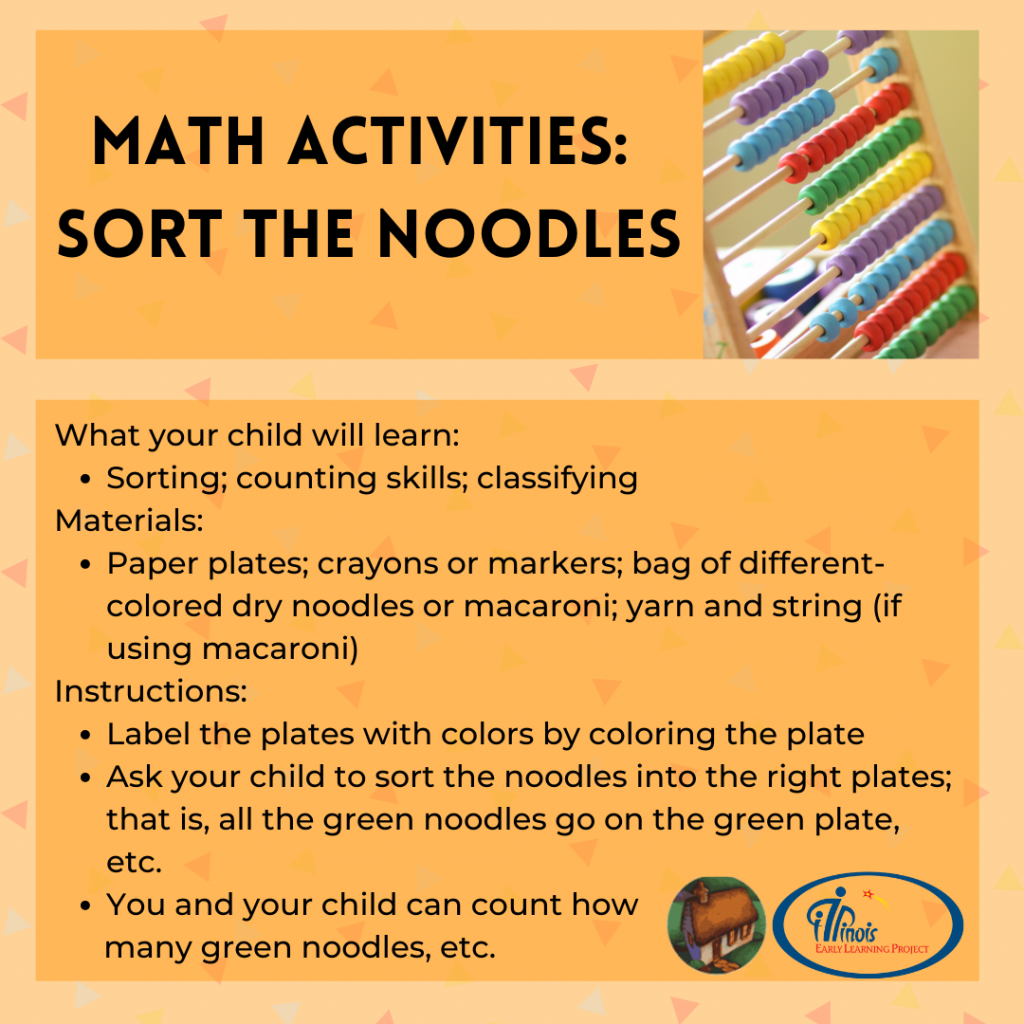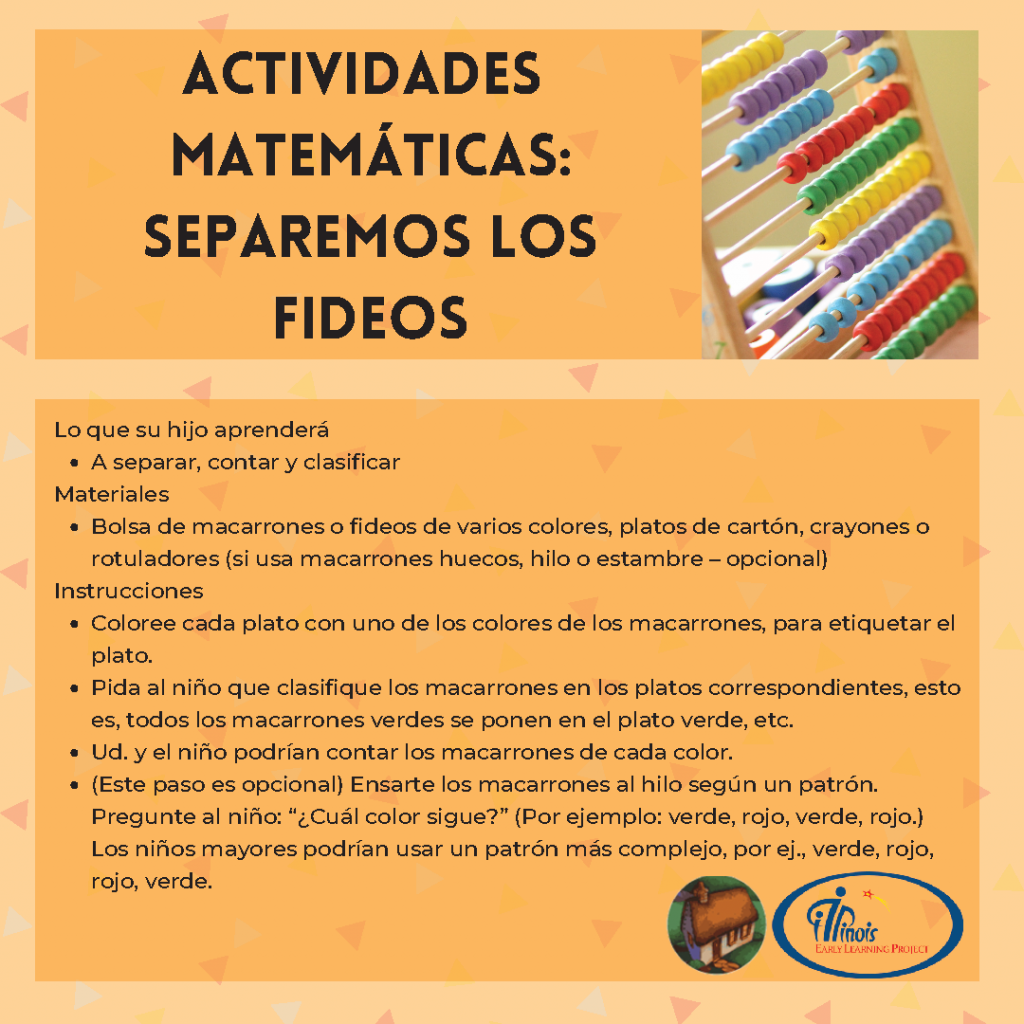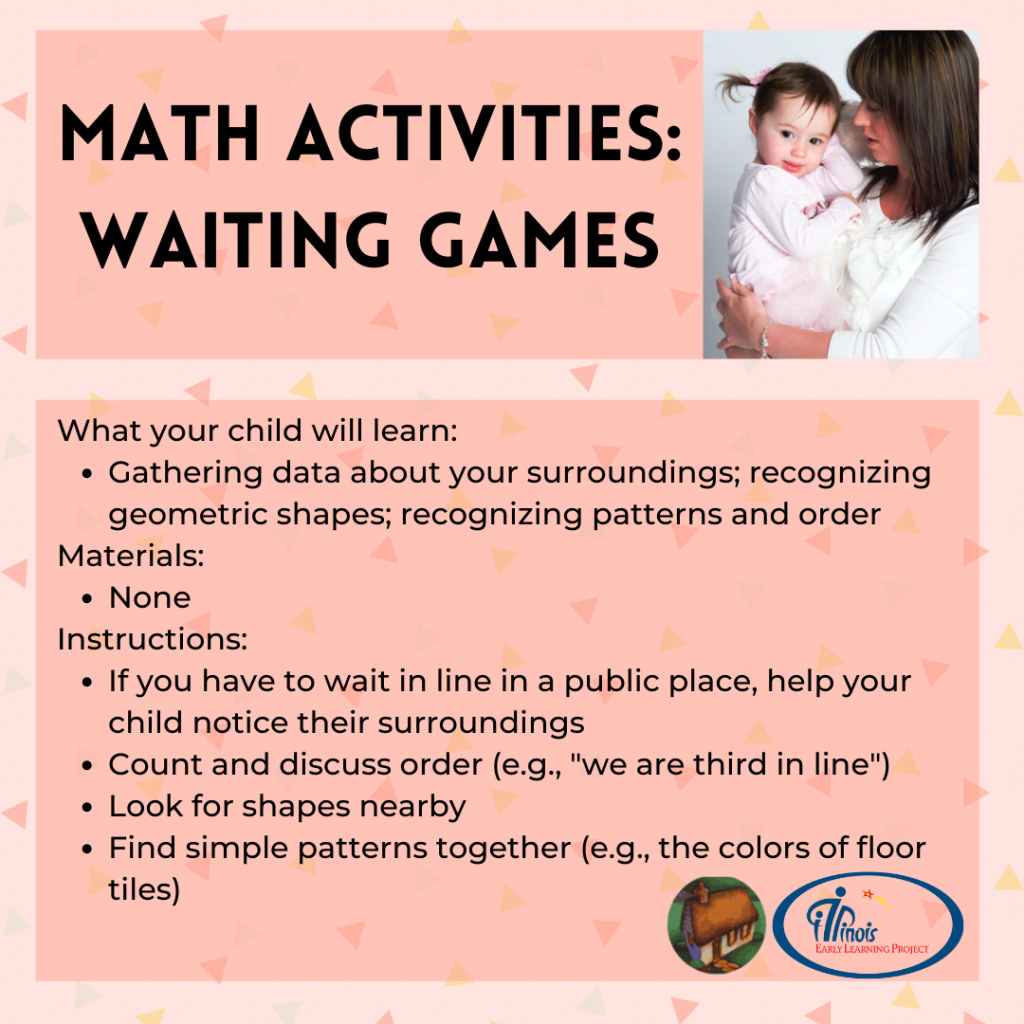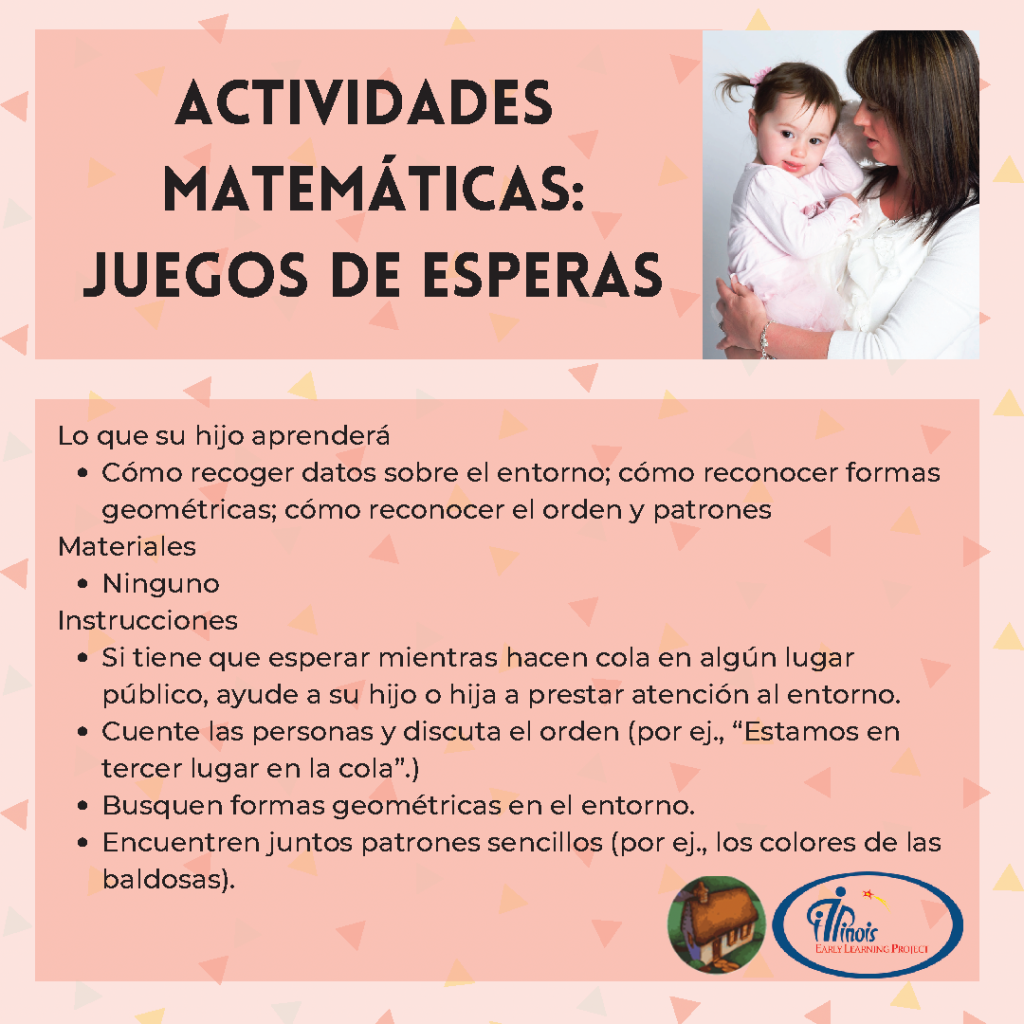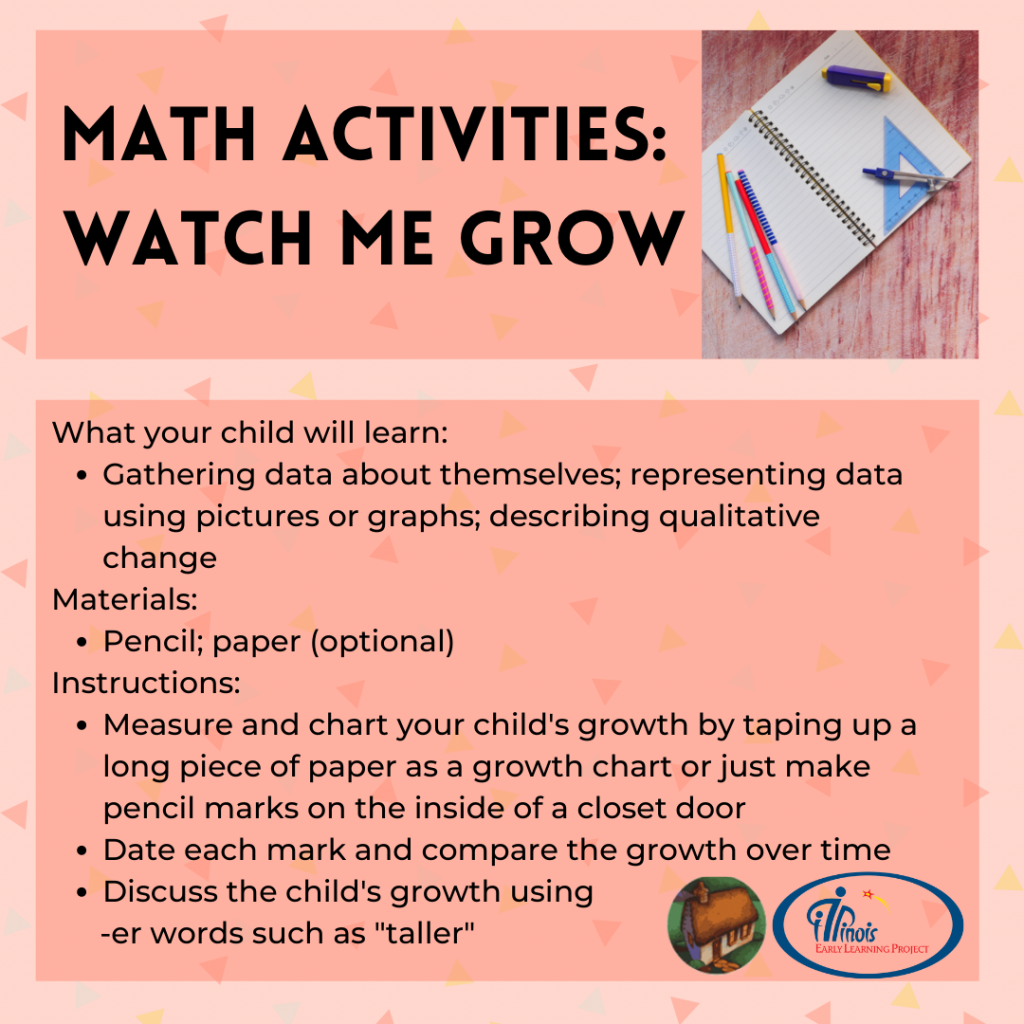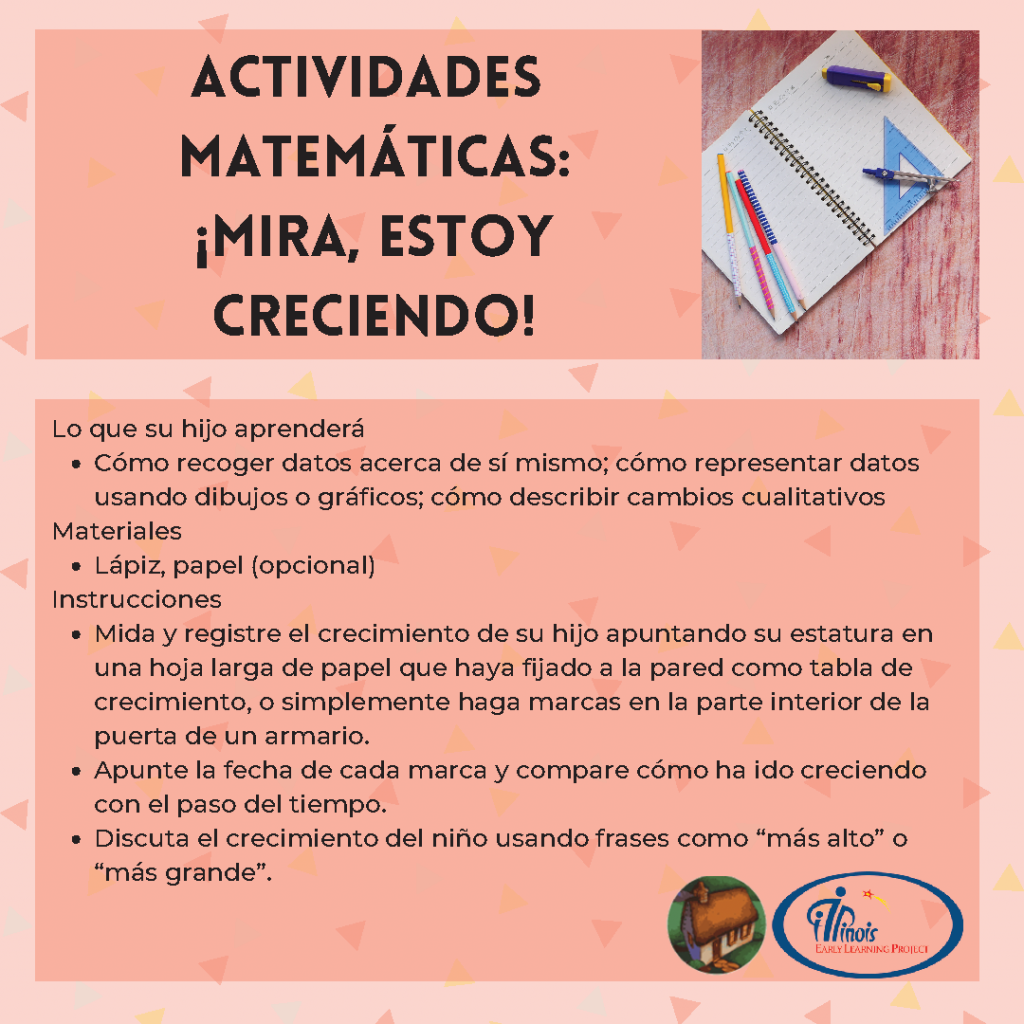Illinois Early Learning has created a bank of slides based on Standards Start at Home: A Guide to Early Learning for Parents/Families. These slides contain simple suggestions for parents of young children. The Standards Start at Home slides are available in PDF format in English and in Spanish. Feel free to electronically share the full document.
Click on the image of any slide below to view, download, and share!
en español
IIllinois Early Learning ha creado una serie de panfletos basados en Las Pautas comienzan en el hogar. Guía para padres y familias sobre el aprendizaje infantil. Estos panfletos presentan sugerencias sencillas para los padres y madres de niños pequeños.
Los panfletos de “Las Pautas comienzan en el hogar” tienen el formato PDF. Les animamos a compartir con libertad el documento completo.
Hacer clic en la imagen de cualquier panfleto de más abajo para ver, bajar o compartir.
Tips for Teaching Children About Patterning and Sequencing (slide 1)
- Provide open-ended materials, such as blocks, Legos, beads, or dry macaroni to encourage your child to explore and create patterns
- Play rhythm games with claps, snaps, and pats
Consejos para jugar con patrones y secuencias (panfleto 1)
- Proporcione materiales con los que se puede jugar de manera abierta, como bloques, Legos, cuentas o macarrones secos para animar a su hijo a explorar y crear patrones.
- Juegue juegos rítmicos batiendo las palmas, chasqueando los dedos y dando palmadas.
Tips for Teaching Children About Patterning and Sequencing (slide 2)
- Collect pairs of similar but different objects, then describe (e.g., “this book is bigger”)
- Use everyday items (shoes, cans, rocks, etc.) and put them in order from smallest to largest
Tips for Teaching Children How to Classify
- Match and sort real objects first. When that becomes easy, use pictures of objects.
- Collect interesting things (shells, rocks, leaves, etc.). Talk about how objects are alike and how they are different.
- Classify stuffed animals by movement (hop vs. swim) or home (farm vs. jungle). Have your child help you sort the laundry or match the socks into pairs.
Consejos para aprender a clasificar
- Primero, halle correspondencias entre objetos reales y clasifíquelos. Cuando esto llegue a hacerse fácil, utilice dibujos de objetos.
- Coleccione cosas interesantes (conchas, piedras, hojas, etc.). Hable sobre cómo los objetos son similares y cómo son diferentes.
- Clasifique los animales de peluche de acuerdo con su forma de desplazarse (dar saltos o nadar) o su morada (la granja o la selva).
Tips for Teaching Your Child About Measurement and Time (slide 1)
- Discuss weights of various foods when putting away groceries. The watermelon is heavy, but the popcorn is light.
- Let your child put spoons or bowls in order of size or nest and stack them
- Talk about how many teaspoons or cups of a certain item are needed in a recipe
Consejos para aprender sobre las mediciones y el tiempo (panfleto 1)
- Discuta el peso de varios alimentos a la hora de guardarlos después de comprarlos— la sandía es pesada pero las palomitas de maíz son livianas.
- Deje que su hijo ponga cucharas o tazones en orden de acuerdo con su tamaño, los amontone o los anide como si fueran tazas encajadas.
- Hable sobre cuántas cucharaditas o tazas de cierto ingrediente se necesitan para una receta.
Tips for Teaching Your Child About Measurement and Time (slide 2)
- See how many cups of water it takes to fill a bowl
- Help your child learn about time by using time words, such as “yesterday we went to the park; we will go to the store after lunch”
- Ask questions to help your child estimate or measure as they play. “How many blocks do you think it will take to make your road reach the wall?” or “Will it take more rocks to fill up the bucket or the basket?”
Consejos para aprender sobre las mediciones y el tiempo (panfleto 2)
- Vea cuántas tazas de agua se necesitan para llenar un tazón.
- Ayude a su hijo a aprender sobre el paso del tiempo al utilizar vocablos relacionados con el tiempo— “Ayer fuimos al parque”; “La cena será a las seis”.
- Haga preguntas para ayudar a su hijo o hija a calcular o medir mientras juega. “¿Cuántos bloques piensas que se necesitarán para que tu camino alcance a la pared?” O: “¿Se necesitarán más piedras para llenar el cubo o para llenar la canasta?”
Tips for Teaching Your Child About Numbers
- Be positive. Your attitude about math will help your child.
- Count out loud as you climb steps, button clothes, stack books, etc. Use counting books with your child.
- Sing songs or say rhymes that include numbers (e.g., one, two, buckle my shoe)
Consejos para aprender sobre los números
- Tenga una actitud positiva; su actitud hacia la matemática ayudará a su hijo.
- Cuente en voz alta mientras sube escaleras, abotona la ropa, amontona bloques uno sobre el otro, etc.
- Cante canciones o recite rimas que incluyan números (por ej., ‘El barquito’—‘Había una vez un barco chiquitito, y el barquito no podía navegar. Pasaron una, dos, tres, cuatro, cinco, seis, siete semanas, y los víveres empezaron a escasear’).
Tips for Teaching Your Child About Shapes
- Provide solid objects that represent shapes for your child to play with. For example, note that cans are cylinders, balls are spheres, and some blocks are cubes.
- Help your child trace around solid objects to see how they look on paper
- Talk about the location of objects. Use words such as “on,” “under,” “near,” and “inside” to describe where you see shapes.
Consejos para aprender las formas geométricas
- Proporcione objetos sólidos, de formas definidas, para que su hijo juegue con ellos—bloques que son cubos o rectángulos, latas en forma de cilindro, pelotas esféricas, etc.
- Ayude a su hijo a trazar el perfil de objetos sólidos para ver cómo se ve su forma trazada en papel.
- Hable sobre la ubicación de objetos. Utilice palabras como “encima”, “debajo”, “cerca de” y “dentro de” para describir dónde ve las formas geométricas.
Math Activities: Counting Bean Bags
What your child will learn: Counting; comparisons
Materials: Coffee cans or buckets; permanent marker, bean bags (you can make bean bags by putting dry beans in the toe of a large old sock and knotting it tightly); paper and/or tape
Instructions:
- Place a large piece of tape or paper on the can or bucket
- Make dots on the tape or paper and have the child count the dots
- Have them throw that many bean bags into the bucket
- Check them together to see that the number of objects in the bucket matches the number of dots on its outside
- Ask your child which container has more? Which has less?
Actividades matemáticas: A contar bolsas
Lo que su hijo aprenderá: Cómo contar y hacer comparaciones
Materiales: Latas grandes de café o baldes, rotulador, bolsas pequeñas llenas de frijoles (se pueden hacer metiendo frijoles secos en el fondo de un calcetín viejo y haciendo un nudo firme), papel y / o cinta adhesiva
Instrucciones:
- Coloque una pieza grande de cinta o papel en la lata o el balde.
- Marque puntos en la cinta o el papel y pida al niño / a los niños que cuenten los puntos.
- Pídales que tiren un número igual de bolsas al balde.
- Verifiquen juntos que el número de objetos en el balde corresponda al número de puntos en la etiqueta.
- Pregunte a su hijo: ¿Cuál recipiente tiene más cosas? ¿Cuál tiene menos?
Math Activities: Shape Hunt
What your child will learn: Recognizing geometric shapes and structures in the environment
Materials: Four empty toilet paper rolls; tape
Instructions:
- Tape two toilet paper rolls together to make “binoculars.” Repeat so you and your child each have one pair.
- Using your binoculars, go on a shape hunt around the house looking for different shapes. For example, a clock is a circle.
- Count how many different shapes you can find. Discuss with your child how many circles or squares you found in the room or in the house.
Actividades matemáticas: Búsqueda de formas
Lo que su hijo aprenderá: Cómo reconocer formas y estructuras geométricas en el ambiente
Materiales: Cuatro rollos vacíos de cartón para el papel higiénico, cinta adhesiva
Instrucciones:
- Fije dos tubos de cartón con cinta adhesiva en forma de ‘binoculares’, y repita este paso con los otros dos tubos para que tanto Ud. como su hijo los tengan.
- Usando los ‘binoculares’, busquen formas geométricas en varias partes de la casa. Por ejemplo, un reloj es un círculo.
- Lleve la cuenta de las formas distintas que pueden hallarse; discuta con su hijo cuántos círculos hallaron en la sala o la casa, cuántos cuadrados, etc
Math Activities: Sort the Noodles
What your child will learn: Sorting; counting skills; classifying
Materials: Paper plates; crayons or markers; bag of different-colored dry noodles or macaroni; yarn and strong (if using macaroni)
Instructions:
- Label the plates with colors by coloring the plate
- Ask your child to sort the noodles into the right plates; that is, all the green noodles go on the green plate, etc.
- You and your child can count how many green noodles, etc.
Actividades matemáticas: Separemos los fideos
Lo que su hijo aprenderá: A separar, contar y clasificar
Materiales: Bolsa de macarrones o fideos de varios colores, platos de cartón, crayones o
rotuladores (si usa macarrones huecos, hilo o estambre – opcional)
Instrucciones:
- Coloree cada plato con uno de los colores de los macarrones, para etiquetar el plato.
- Pida al niño que clasifique los macarrones en los platos correspondientes, esto es, todos los macarrones verdes se ponen en el plato verde, etc.
- Ud. y el niño podrían contar los macarrones de cada color.
- (Este paso es opcional) Ensarte los macarrones al hilo según un patrón. Pregunte al niño: “¿Cuál color sigue?” (Por ejemplo: verde, rojo, verde, rojo.) Los niños mayores podrían usar un patrón más complejo, por ej., verde, rojo, rojo, verde.
Math Activities: Waiting Games
What your child will learn: Gathering data about your surroundings; recognizing geometric shapes; recognizing patterns and order
Materials: None
Instructions:
- If you have to wait in line in a public space, help your child notice their surroundings
- Count and discuss order (e.g., “we are third in line”)
- Look for shapes nearby
- Find simple patterns together (e.g., the colors of floor tiles)
Actividades matemáticas: Juegos de esperas
Lo que su hijo aprenderá: Cómo recoger datos sobre el entorno; cómo reconocer formas
geométricas; cómo reconocer el orden y patrones
Materiales: Ninguno
Instrucciones:
- Si tiene que esperar mientras hacen cola en algún lugar público, ayude a su hijo o hija a prestar atención al entorno.
- Cuente las personas y discuta el orden (por ej., “Estamos en tercer lugar en la cola”.)
- Busquen formas geométricas en el entorno.
- Encuentren juntos patrones sencillos (por ej., los colores de las baldosas).
Math Activities: Watch Me Grow
What your child will learn: Gathering data about themselves; representing data using pictures or graphs; describing qualitative change
Materials: Pencil; paper (optional)
Instructions:
- Measure and chart your child’s growth by taping up a long piece of paper as a growth chart or just make pencil marks on the inside of a closet door
- Date each mark and compare the growth over time
- Discuss the child’s growth using -er words such as “taller”
Actividades matemáticas: ¡Mira, estoy creciendo!
Lo que su hijo aprenderá: Cómo recoger datos acerca de sí mismo; cómo representar datos usando dibujos o gráficos; cómo describir cambios cualitativos
Materiales: Lápiz, papel (opcional)
Instrucciones:
- Mida y registre el crecimiento de su hijo apuntando su estatura en una hoja larga de papel que haya fijado a la pared como tabla de crecimiento, o simplemente haga marcas en la parte interior de la puerta de un armario.
- Apunte la fecha de cada marca y compare cómo ha ido creciendo con el paso del tiempo.
- Discuta el crecimiento del niño usando frases como “más alto” o “más grande”.
